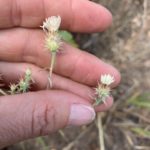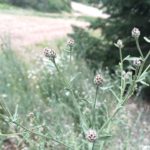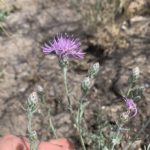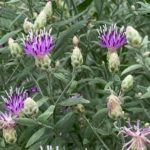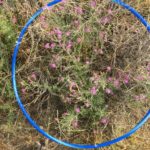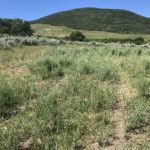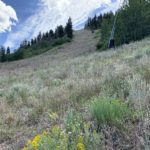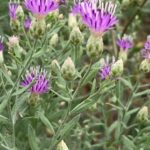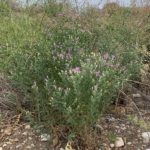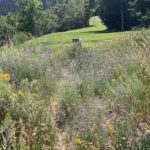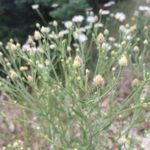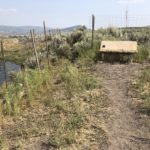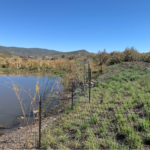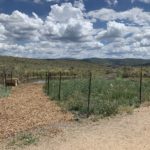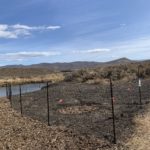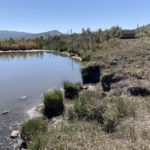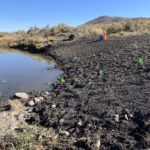Summit CWMA Knapweed, Yellow Starthistle & Phragmites Control Program
Description
With increasing rates of development in Summit and adjacent counties, the number of knapweed populations has also increased at an alarming rate. In 2018 and 2019, the Summit CWMA began mapping knapweed while out monitoring for garlic mustard. The populations were growing but appeared to be at a level that may still be controllable. In 2019, the Summit CWMA decided to submit a grant application to begin formal mapping and treatment of spotted knapweed (Centaurea stoebe), diffuse knapweed (Centaurea diffusa), and Russian knapweed (Rhaponticum repens).
In addition to the three knapweeds, the Summit CWMA was aware of two populations of the closely related and very problematic noxious weed, yellow starthistle (Centaurea solstitialis). Given this limited distribution, yellow starthistle was added to the knapweed project. In 2022, the Summit CWMA added Phragmites to this project due to rapid spread of this species in watershed areas within the Snyderville Basin. Most recently in 2023, a single population of squarrose knapweed (Centaurea virgata) was identified for the first time in Summit County. Residents should be on the lookout and report to the Summit CWMA if seen.
The primary goals of the project have been to gain a better understanding of how widespread these species are, establish an increasingly accurate map of known populations, develop a strategic plan for control, implement control and restore lands as we gain control of each population. We do this through shared mapping technology, grant funded contractors applying integrated pest management and public outreach.
The six species are class 2 and 3 state listed noxious weeds. Each diminish soil health through releasing chemicals in the soil that inhibit germination of other plants and suppresses the natural, soil fungal and bacterial communities most plants rely on for nutrients, water and protection from disease. These species displace native vegetation, decrease available wildlife forage, and negatively impact ecosystem diversity. Yellow starthistle invasion leads to additional health threats as its thorns are known to puncture eyes, mouths and feet of wildlife and domesticated animals from elk and cattle to dogs. Injury from starthistle can cause infections and in some species such as horses, chewing disease. Once these noxious weed species establish, the amount of bare ground significantly increases between the plants and these exposed soils become more susceptible to wind and water caused erosion that can lead to reduced water quality through sedimentation of local waterways.
Together, these knapweeds, starthistle and Phragmites are known to cover more than 223 acres in western Summit County with spotted knapweed at 159 acres, Phragmites at 41 acres, diffuse knapweed at 19 acres, Russian knapweed at 4 acres and yellow starthistle at 0 acres. All these species are at a level where eradication (complete control) is still possible, but the rate of spread has significantly increased in the last couple years, the window of opportunity is quickly closing. With funding from the Utah Department of Agriculture and Food, the Summit CWMA is able to work with private and public landowners to control these weeds on their property.
Control
Early detection, rapid response (EDRR) is being implemented in these areas; the process involves survey, mapping, control measures and continued monitoring. Control methods for these noxious weed species include herbicide, biological control agents, hand weeding and restoration of degraded lands.
Herbicide
All four species are best controlled with herbicide. The Summit CWMA uses selective herbicides, such as Milestone (active ingredient: Aminopyralid), to have the greatest impact on the noxious weed while minimizing any unintended impact on other plant species. The herbicide is most effective when applied to seedlings/rosettes, in the late summer while plants are in flower and fall as the plant works to draw nutrients into its roots before winter. Since the Summit CWMA began mapping and controlling knapweeds and starthistle, 155 acres have been mapped and at least 60 acres are treated annually.
Biological Control Agents
In Summit County, two biological control agents (biocontrols) are being used successfully to control the knapweed species.
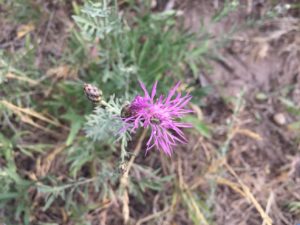
These species include Knapweed root weevil (Cyphocleonus achates) and knapweed seed weevil (Larinus minutus). In western Summit County, biocontrols are the preferred method for treating populations on steep open slopes, such as steep ski runs. Thanks to the dedication of the Summit County Weed Supervisor’s commitment to the increased use of biocontrols, these weevils have been used on knapweed 37 times in Summit County. Along with the biocontrols, herbicide is still used along population edges after biocontrols are released to prevent expansion of knapweed while the biocontrols settle in.
Hand Weeding
Hand weeding for knapweed has limited effect because most of the root must be removed and the compact, dry soils knapweeds prefer make hand pulling difficult. Repeat damage that does not kill the plant can cause the plants to overcompensate and shift from a biennial (plant with a 2-year lifespan) to a long-lived perennial. Hand removal is often limited to small populations where full removal of the roots is likely. Starthistle, on the other hand is often hand weeded to prevent seed. In Summit County, yellow starthistle is limited and given the substantial, negative impact this plant can have, the Summit CWMA relies on the most effective treatment, herbicide, to ensure no new populations are found.
Revegetation
Revegetation is an important step to restoring ecosystems. Perennial grasses help reestablish a competitive native plant community and nitrogen fixing plants can be added to restore soil health. The Summit CWMA is currently restoring 6 locations of previously invaded areas, with a long-term goal of reseeding approximately 16 acres across the county. When funding allows, our method is to prepare soils by spreading three to five inches of a compost/biochar blend prior to a seeding of native grasses. Because knapweeds tend to invade poor quality and disturbed soils, the use of soil amendments to prepare soils for seeding has greatly increased establishment of seeded natives.
Spotlight Restoration
Round Valley Pond Russian Knapweed Control and Restoration Project
Russian knapweed had invaded and dominated areas around the one intact pond in the Round Valley open space of Park City. After three years of heavy control with milestone, weeding seeding plants and raking away dead knapweed plants, the site was below 5% cover of Russian knapweed. In addition to the knapweed, the pond had experienced a great deal of erosion and native plants were not reestablishing. In 2020, we recontoured the eroded pond banks and turned compost and biochar into the upland areas where Russian knapweed had previously dominated. The bare ground was seeded with native grasses and wildflowers and native shrub seedlings and 1-1.5-inch caliper narrowleaf cottonwood (Populus angustifolia) were planted. Fall of 2020, willow canes were planted along portions of the pond bank to help stabilize the bank and reduce dog traffic through the areas most sensitive to erosion and reduce knapweed seed distribution further down into the wetland downstream.
In 2021, the area experienced dense establishment of native grasses and sparse establishment of wildflowers. Rubber rabbitbrush shrubs seedlings had tripled in size or more and other native shrubs survived the winter. Eighty percent of the cottonwoods that had been planted around the pond had survived the winter, but all but three died during the 2021 summer droughts. Approximately 50% of the willow canes established and were healthy by fall of 2021. Russian Knapweed cover remains below 5% and can be maintained with hand weeding to reduce herbicide impact on establishing native wildflowers.



